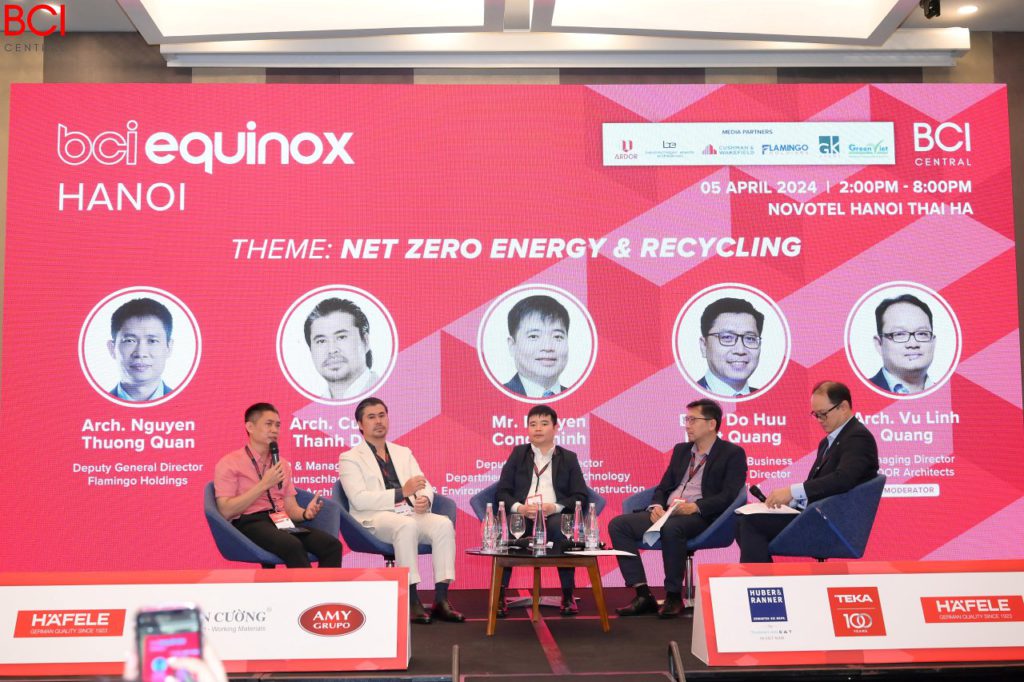Net Zero Energy & Recycling: BCI Equinox Hanoi 2024
HANOI, 18 APRIL 2024 – According to the World Bank, Vietnam is one of the 10 countries most affected by climate change and natural disasters globally. Its construction sector makes up around 38 per cent of the nationwide carbon emissions,1 and it is strategising to meet net zero targets by 2050. The International Finance Corporation (IFC) reported that at the end of December 2023, Vietnam has only had 396 buildings that meet Green standards across the country—which means that there are still many challenges and opportunities for industry players to implement sustainable practices in the years to come.

The roadmaps and recent developments in Green construction were a hot topic of discussion among industry leaders at BCI Equinox Hanoi 2024, which took place at Novotel Hanoi Thai Ha on Friday, 5 April 2024 and attracted an audience of over 350 construction professionals and students.
This is the second time since 2023 that the event has been held in Hanoi, and this year, the panel discussion highlighted the importance of recycling as a strategy to increase Green targets.
A roadmap for opportunities
The discussion began with an overview and status update of Green buildings and solutions in the real estate and building materials market. Moderator Vu Linh Quang, Managing Director of ARDOR Architects began by raising a question to the panellists: “Green buildings, net zero energy buildings and recycling have many advantages—so why are there not many of these projects in Vietnam? Is it due to a lack of knowledge, high costs or insufficiency constraints?”
Representing the Ministry of Construction, Nguyen Cong Thinh, Deputy General Director at the Department of Science Technology outlined the government’s commitment to support Green targets: “By 2030, it is expected that 25 per cent of construction materials in Vietnam such as cement, tiling materials, and construction glass that are mainly produced domestically will have to be certified as Green products.”
After 2030, the Ministry of Construction has set a target that 100 per cent of new construction projects will carry out greenhouse gas inventories and apply solutions to reduce emissions. All planning projects and general urban planning adjustments should also integrate climate change adaptation strategies. Nguyen also stated that the government will implement a set of policies to promote sustainable construction, which include supporting the establishment of construction waste recycling centres and providing resources for the production of low-carbon materials.
As their practice has created more than 10 Green-certified buildings in Vietnam, architect Nguyen Thuong Quan, Deputy General Director of Flamingo Holdings shared the office’s driving force for sustainable construction, which is to stay ahead of the market demand. “How we build urban areas over the next 10 years is very important. Commercial real estate developers, owners and operators are beginning to see the Net Zero goal as an indispensable competitive advantage … it will become the number one goal after Green building certification,” he said.
With decades of professional experience, the international firm Baumschlager Eberle Architekten (BEA) had designed the world’s first building that did not require energy for its heating or cooling systems—an office project called 2226 in Austria. In the context of Vietnam, how has the firm prepared to keep updated with new technical requirements, design standards and regulations related to net zero targets? According to Cung Thanh Dat, CEO and Managing Director of BEA: “Renovating existing buildings is important, because it can reduce 50–75 per cent of carbon emissions, especially if the building foundations are reused.” He also highlighted the opportunities to rejuvenate buildings in the commercial sector, with only one-fifth of Hanoi’s Grade A office buildings receiving Green certification by December 2023.
The final panellist, engineer Do Huu Nhat Quang who is the Co-founder and Business Development Director of GreenViet and Vice President of Ho Chi Minh City Green Architecture Club shared insights about transforming any business operations to be more sustainable within three years. “In the first year, businesses need to grasp the basic concepts of sustainable development, assessing what has or has not been done … in the second year, choose key Green standards to pursue, practice greenhouse gas inventories and prepare sustainable development reports … by the third year, businesses will be able to set further sustainable development strategies in the medium and long term.”


Related stories:
Healthy Homes: The Importance of ‘Blank Spaces’

Buon Ma Thuot University Hospital

A countryside sanctuary for a farmer: The Second by CTA

1 https://www.reccessary.com/en/news/vn-environment/vietnam-has-305-green-buildings-but-still-lacks-mandatory-regulations


